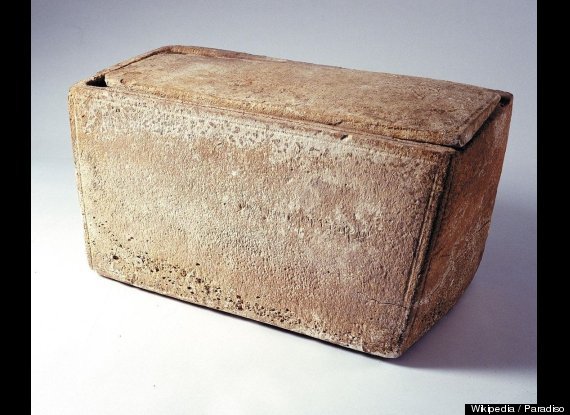以色列法庭法官表示,經過七年正反雙方的辯論耶穌兄弟骨甕非偽還被造的清白
長50釐米、寬27釐米的骨罐上刻著銘文:雅各,約瑟的兒子,耶穌的兄弟”字樣,顯示基督徒難逃一死,空等日後復活終是個笑話

“
在耶路撒冷法院認定私人古董商Oded Golan沒有犯偽造銘文罪之後,圍繞着一個古代的葬盒的神秘仍在繼續,據說這個葬盒與聖經經文“耶穌的弟兄,約瑟夫的兒子雅各”有關。
法庭表示這個約有2000年曆史的古老盒子有可能“繼續在考古學和科學領域被調查,時間將會說明真相,”據路透社消息報道。法院的決定為這起2004年就被提起的法律爭議畫上了句號。
“我很高興,在過去幾年我需要面對的、所有針對我的嚴厲指控中我被認定是無辜的,”Golan 對路透社說,在他被耶路撒冷地區法院的Aharon Farkash牧師宣告無罪釋放后。雖然Golan沒有觸犯被指控的偽造銘文罪,但是根據古物法,他卻被認定犯有其他罪。
Golan宣稱得到了所謂的裝有“雅各的骨灰”的盒子,還有一個古代的描述約阿施王對第一個聖殿所做的革新的小板,這塊板是Golan約10年前從耶路撒冷東部的阿拉伯商人那裡得到的。
這個盒子上的銘文對很多小組都有重要意義,如果它確實是指向耶穌基督的話。聖經中的馬太福音、馬可福音和加拉太書都提到了雅各是耶穌的弟兄,雖然羅馬天主教和一些其他群體認為耶穌沒有兄弟姐妹。如果這是真實的,這個骨灰盒將被視為已發現的耶穌基督的生活的最確實的證據之一。
以色列古物局 (Israel Antiquities Authority,簡稱IAA)的兩個委員會(他們負責審查整個國家的考古事件),在2003年表示這個骨灰盒是真的,但是上面的銘文是被偽造上去的。 有人認為Golan為了賺錢偽造了這個銘文,IAA建議(以色列)國家應該對他展開調查。
Like us on Facebook
繼周三法院作出決定之後,IAA發佈了一個聲明表示他們尊重法官的決定,並且以“為了尋求國內外的公共利益而做出的決定而自豪,這個決定宣稱干擾歷史當中的以及居住在以色列境內的任何人的個人事務都是被禁止的。”
“在庭審過程中,法官出示了以色列古物局的專家委員會和大學的結論,這些結論都指出這個銘文是偽造的,”以色列古物局的聲明中表示。“法院不得不在考古領域對專業問題作出決定,這在法庭上並不是常見的。因為一個人的罪行必須在理性的懷疑之外被證實,最後Golan被宣告無罪。”
聖經考古學會 (Biblical Archaeology Society)創建者兼《聖經考古評論》(Biblical Archaeology Review)的編輯Hershel Shanks,在聖經每日曆史(Bible History Daily)網站上對這個裁定發表了一篇文章,來解釋為什麼他不贊同IAA的觀點,並且他認為這個銘文是合法的。
Shanks辯稱IAA委員會被設立來發現被偽造的物件,並且他譴責堆積了權威委員會專家們早已經推測這些物件是偽造的。他還提供了詳細的科學解釋來闡釋為什麼他認為這個史前古器物或許是真品。
“不管我所說的一切,我所討論的這個銘文在公眾的意識里將被認為是偽造的,至少一代人將不會在意這個被指控者的無罪釋放和權威部門的證據。”Shanks說。
Oded Golan, James Ossuary Proponent, Acquitted of Antiquities Fraud
http://www.huffingtonpost.com/2012/03/14/oded-golan-james-ossuary-acquitted-of-antiquities-fraud_n_1344994.html
JERUSALEM -- Is the purported burial box of Jesus brother James fake or authentic?
Seven years of trial, testimony from dozens of experts and a 475-page verdict Wednesday failed to come up with an answer.
A Jerusalem judge, citing reasonable doubt, acquitted Israeli collector Oded Golan, who was charged with forging the inscription on the box once hailed as the first physical link to Christ.
Golan said the ruling put an end to what he portrayed as a 10-year smear campaign against him. Hershel Shanks, editor of the Washington-based Biblical Archaeology Review, said he was delighted, insisting the burial box, or ossuary, is authentic and a "prized artifact to the world of Christianity."
The Israel Antiquities Authority, which believes Golans most high-profile items are forged, said the case shows the limits of science in proving forgeries, but it also prompted museums and universities around the world to be more suspicious of finds of uncertain origin.
In his ruling, Judge Aharon Farkash of the Jerusalem District Court said Wednesday that he heard so many specialists with conflicting claims that he could not determine whether the ossuary was forged.
"This topic is likely to continue to be the subject of research in the scientific and archaeological worlds, and time will tell," Farkash wrote
The case of the burial box is likely to be irrelevant to believers.
Stephen Pfann, an archaeologist and president of the Christian Holy Land University, said Christians dont need objects to prop up their faith. "In a way, there will always be that necessity of faith to be involved in a persons convictions, whether or not we find artifacts associated with the story," he said.
Much of the trial focused on the patina over the inscriptions of the ossuary and a second find, a stone tablet purportedly carrying instructions by King Yoash of the 9th century B.C. on maintenance at the Jewish Temple. The patina is a thin layer of grime that can attest to the age of engravings.
At one point, the prosecutor brought a camp stove, chalk, beaker and other ingredients to show how easy it is to make fake patina, said journalist Matthew Kalman, a frequent trial observer. The defense then used the same technique to show that fake patina doesnt stick to stone.
"It began to look like a high school chemistry class," said Kalman, editor of The Jerusalem Report magazine.
The saga began in 2002 when Golan sent the ossuary with the Aramaic inscription "James, son of Joseph, brother of Jesus" to Torontos Royal Ontario Museum. Shanks was among its early enthusiasts, publishing the first report on it in 2002.
Golan has said hes owned the ossuary since the late 1970s and never paid much attention until a visiting French expert suggested the inscription might refer to the brother of Jesus.
After the Toronto exhibit, he started facing questions at home.
At first, the antiquities authority investigated whether he had transferred the box abroad with the proper license. It also questioned where the Yoash tablet, inscribed with 15 lines in Hebrew, came from. Eventually, IAA experts concluded both were forgeries, and police began to investigate.
Golan was indicted in late 2004, along with four other defendants, charged with forging and trading in dozens of stolen items. His trial began in 2005.
Witnesses in the trial – more than 100 hearings transcribed in 12,000 pages – described a dark underside to the Holy Land antiquities trade, including grave robbing and shadowy exchanges of fistfuls of cash on West Bank roads.
Shanks said finds should not be automatically dismissed because of uncertain origin.
"You have much looted material coming out of Judea and Samaria (the West Bank)," he said. "It has died down now but was once great. These finds can be important. Are you going to rescue them, or are you going to say you arent going to learn from them because they were looted?"
Archaeologist and biblical historian Eric Meyers of Duke University said questions about where Golan obtained the ossuary make it all the more important to regulate the antiquities trade in Israel.
"Israel is unique in the Middle East for allowing antiquities dealers to operate under official government licensing," he said. "This is a dirty business ... and the Israeli police and antiquities authority have trouble dealing with all this chicanery."
During the trial, the Israel Museum re-examined its collection to remove forged items, and museums and universities have grown more suspicious of undocumented finds, said Shai Bartura, an IAA official.
"People just do not want to take chances," he said. "If its not absolutely legitimate, if it doesnt have an archaeological context, then most serious facilities of display or research simply will not touch it."
Golan was convicted Wednesday on four other charges, including trading unlicensed antiquities, possessing stolen artifacts and selling artifacts without a license. The court will consider Golans sentencing in April.
Robert Deutsch, an inscriptions expert, was acquitted Wednesday of all charges. He was accused of forgery, but not in connection with the ossuary and the tablet.
In earlier proceedings, one defendant reached a plea bargain, while charges against the remaining two were dropped.
Also on HuffPost:




